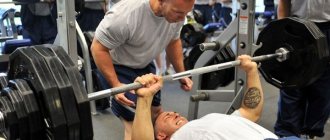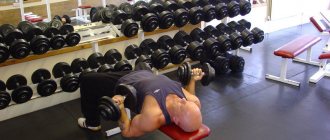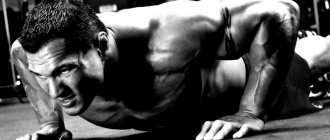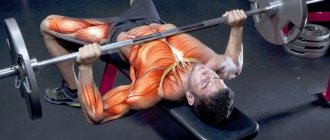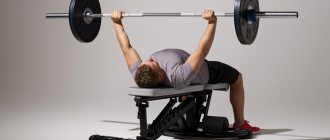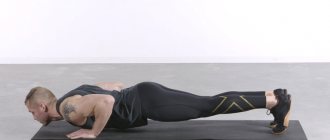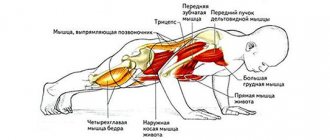Bench press
Of course, the bench press is a basic exercise that is popular among men working out in the gym. And it’s not for nothing that it is so popular, because the bench press is aimed at developing the shoulder girdle, which makes a man’s figure more masculine (if you want). Presses have a number of advantages. Here are the main ones:
- A highly effective exercise for gaining muscle mass, strength and size of the target muscles.
- Involves the chest muscles, as well as many auxiliary muscles: abs, triceps, anterior deltoids, serratus anterior muscles. The quadriceps are also involved in the work, but their role is small, since the legs are position stabilizers.
Yes, of course, exercise to some small extent has a positive effect on the cardiovascular and respiratory system. It can strengthen ligaments and be implemented in training aimed at increasing weight and strength, and even in fat burning, but it has a narrow range of targeting the target muscles and, by and large, is a strength exercise for developing chest muscles.
There are several basic schemes for performing the bench press, namely low-repetition (1-6 repetitions), aimed at developing muscle strength, and high-repetition (14 and above) aimed at reducing body weight. Medium reps are an effective way to increase mass and size, in other words, build muscle (8-12).
Are there any disadvantages to the bench press? Rather, the disadvantage can be called the mandatory presence of equipment for its implementation, and this is at least two dumbbells or a barbell and weights, a bench for a press.
What is good about the standing barbell press?
It will no longer be possible to cope with this exercise “anywhere”, as with the previous option, since specialized equipment will definitely be required to perform it.
However, this training method has one very significant advantage: it does not have any ceiling on the maximum load on the muscles, which will allow the athlete to gain significantly more muscle mass than when training with push-ups. By selecting the weight of the barbell, you can rebuild this exercise to develop mass, physical strength or endurance. This is convenient for those who have access to a gym on a regular basis or can train with barbells at home.
To summarize the comparison, it can be noted that:
· Both exercises are aimed at achieving the same result;
· The barbell press opens up significantly more opportunities for development.
Source
Pushups
This exercise is great for training in different areas. First of all, it should be used as a general strengthening exercise, because push-ups involve a large number of muscles. The muscles receive a powerful static load by maintaining the body position. If in a bench press a person experiences the load only from holding the weight of sports equipment while lying on a bench, then in push-ups from the floor the athlete’s body is constantly under tension. Due to this, the athlete uses the following muscles during push-ups:
- The main (target) ones are triceps and pectoral.
- The secondary muscles involved are the anterior deltoids and abdominal muscles.
- In statics, the back muscles work, which hold the spine and do not allow it to sag, and the muscles of the lower back and, to a lesser extent, the gluteal muscles also participate in the work.
There are many advantages to push-ups:
- Excellent for working several muscle groups without additional equipment.
- Can be performed anywhere - on the street, at home or in the gym.
- If the bench press may have contraindications, for example, spinal injuries, due to which it is impossible to create compression (pressure on the spine), then push-ups from the floor do not have such disadvantages and are quite relevant for both children and the elderly. Moreover, push-ups can be an exercise in a complex of others aimed at rehabilitation after injuries of various types.
- The exercise is suitable for an athlete of any level of physical fitness, regardless of training goals.
- Push-ups develop endurance, the respiratory and cardiovascular systems, strengthen ligaments and expend a lot of energy, which has a positive effect on fat burning and metabolism.
Of course, you can find disadvantages to push-ups. The first and main disadvantage is the inability to develop massive muscles. Push-ups can create well-developed, high-quality mass, but it is impossible to create impressive volumes with their help.
Which is more effective?
By performing at least one of these exercises competently, correctly and technically, you can get a good result. Features of classes for men and women:
To summarize, it is worth noting that both of these exercises are useful, effective and have a positive effect on the development of the torso muscles. It is recommended to approach the choice of exercise on an individual basis. Consider the advantages and disadvantages, evaluate your capabilities, etc.
An important fact will be to take into account the injury risk of each of them. Including personal predisposition to possible injury. Ideally, it is better to alternate these two exercises to diversify the load and activate the process of muscle growth.
Source
Conclusion
So what should you choose – push-ups or bench press? In fact, these are two different exercises; they can be performed together in a training program. For example, in home workouts, push-ups can be performed before bench presses with dumbbells or barbells. Thus, push-ups will prepare the athlete for the subsequent load and will be an excellent warm-up. By the way, it is not necessary to use push-ups before dumbbell bench presses. Doing push-ups is also important after bench presses with dumbbells. In this case, the athlete will create a powerful pump and work the muscles deeply.
Also read: Kettlebells or dumbbells – which is better? Which is better, a strategy for gaining muscle or burning fat? Lunges or squats - which is better for developing legs?
Typical beginner mistakes
The bench press is one of the basic exercises; its technique is not complicated, but requires careful study to avoid injury and achieve better results.
Assessing your strengths
Many athletes, obeying the competitive moment, try to lift a lot of weight at once. This makes training ineffective and dangerous. It is better to take a weight that is comfortable enough to lift without straining yourself. The athlete should be able to lift and lower the barbell 5 times without any problems. It is better to start training with minimal weight, gradually adding it so as not to strain the muscles with too much stress.
Start lowering the barbell from the place where you will raise it
This is a very simple habit, but not everyone has it. Most lifters remove the bar from the rack and immediately begin to lower it without securing it. This becomes a habit and forces you to lower the bar diagonally, which will lead to the rise in the same manner. When you lift the bar toward the racks, it overloads your shoulders and takes the emphasis off your triceps.
After removing the bar from the racks, you must move it to the point where you will lift. It should be slightly higher than the place where you will lower the barbell. If you are lowering to the lower chest area, the bar should be secured above the lower chest before lowering. This will ensure a straight trajectory in both the eccentric and concentric phases.
Remember, the shortest distance between two points is a straight line.
Bench press 200 kg - Phase No. 2 “Connecting the utility room”
Want to know how to increase your bench press best? Then read the article Bench press 200 kg - Phase No. 2 “Connecting the utility room”
After you have completed the first and initial stages of bench press training, it’s time to now move on to the second stage of your training to increase maximum results in the bench press, which in turn is based on the fact that we connect auxiliary exercises to the main exercise, the bench press.
And we are already building our training program exclusively around the main exercise of the bench press; this is necessary, first of all, in order to strengthen and tighten all the muscles involved in the movement itself.
Otherwise, if at least one muscle group lags behind the others and plays the role of a weak link, this will immediately affect the performance of the exercise itself and the movement as a whole. Therefore, it is necessary to strengthen and eliminate all weak points, and only after that your results in the bench press will immediately begin to increase.
What muscle groups are involved in the bench press?
When performing the bench press exercise, during the movement itself, a huge number of both main and auxiliary muscle groups are involved, which in one way or another are involved in the movement process itself, both directly and indirectly helping the main muscles overcome the load on the muscles. By strengthening and working the major muscle groups, you also strengthen other small auxiliary muscles.
Main muscle groups involved in the Bench Press:
As I said above, these are not all the muscles involved in the bench press, because this movement also involves a huge number of auxiliary muscle groups that receive indirect load in this exercise. And the entire main function falls on these five main muscle groups, which in turn are responsible for the quality (technique) and maximum results in this exercise.
In order to increase your result in the bench press, you need to maximally strengthen all existing muscle groups involved in the movement itself.
Therefore, you should select certain exercises for each muscle group; there should not be too many of them; 1-2 exercises for each muscle group are enough.
Basic assistance exercises for the Bench Press:
- Pectoral muscles: Dumbbell flyes and dumbbell press (power)
- Triceps Muscles: French Press and Dips
- Biceps Muscles: Reverse Grip and Classic Barbell Raises
- Deltoids: Front dumbbell raises and standing or seated presses
- Latissimus: Bent-over rows and Pull-ups
Why is it necessary to do any kind of utility work?
It would seem that in order to increase your results, it is enough to do only one bench press, and the rest of the muscles themselves will become stronger in the process of work. But in reality this is far from the case!
Of course, at a certain stage, namely at the initial stage of training, it is enough to perform only one exercise using various power pyramids and your results will increase.
But as soon as you reach your maximum peak, your results then slow down sharply or stop altogether, and all because the muscles involved in the bench press have simply exhausted their power resources (potential) and can no longer cope with the new weights that you impose on them and in the end these new weights are simply not given to you.
In order to increase your results and conquer new weights, you need to increase the power resources (power potential) of your muscles, i.e. those muscles that are involved in the movement itself. After you strengthen all your muscles and increase the strength of each muscle group taken separately, only then will you overcome your new maximum weights.
How to understand which muscle groups are lagging behind?
Each muscle group plays a specific role in the overall movement, strengthening which you build a solid foundation for new maximum results (weights). Therefore, comprehensive work on each muscle group is necessary because each muscle group influences the performance of the overall movement in the bench press.
The influence of muscle groups on the overall movement in the Bench Press:
Problems with falling off the chest and poor “acceleration” of the barbell:
If you have problems with the release from the chest, as well as poor acceleration of the barbell, then this means that you have weak pectoral muscles and deltoids. In order to strengthen this area of the overall bench press movement, you need to add support and strengthen these muscle groups.
- Deltoids: Front dumbbell raises and standing or seated presses
- Pectoral muscles: Dumbbell flyes and dumbbell press (power)
The bar gets stuck in the middle:
If you are having problems with the bar getting “stuck” in the middle of the path, i.e. at the level of the dead center in the range of bending the elbow and arms from 80 - 90 degrees, followed by the transition to straightening the arms with pressing the barbell. This means that you have weak pectoral and triceps muscles. In order to eliminate this, it is necessary to work and strengthen these muscle groups.
- Pectoral muscles: Dumbbell flyes and dumbbell press (power)
- Triceps Muscles: French Press and Dips
Poor stabilization of the barbell when lowering to the chest and lifting:
If you have problems with poor stabilization of the barbell when lowering to the chest and lifting, for example, if the barbell swings with outstretched arms, then this means that weak muscles are the deltoid muscles and latissimus dorsi. Or, when lowering the barbell, it is not stable and falls on your head or in the abdominal area, which means that you have weak biceps and triceps muscles that are not able to keep the barbell in balance. In order to eliminate this, it is necessary to work and strengthen these muscle groups.
- Latissimus: Bent-over rows and Pull-ups
- Deltoids: Front dumbbell raises and standing or seated presses
- Biceps Muscles: Reverse Grip and Classic Barbell Raises
- Triceps Muscles: French Press and Dips
Problems with pressing the barbell:
If you have problems with the end point, namely pressing the barbell, then this means that you have weak triceps and deltoid muscles. In order to eliminate this, it is necessary to work and strengthen these muscle groups.
- Triceps Muscles: French Press and Dips
- Deltoids: Front dumbbell raises and standing or seated presses
As you can see, each muscle group is interconnected with the other, which all together form one holistic and powerful movement mechanism in the bench press. Therefore, if you want to increase your maximum bench press results, then work on every muscle group without exception.
What are the best assistance exercises?
There are many different exercises for these major muscle groups, but not all are equally effective. Therefore, in order to figure out which exercises are most effective, I have compiled a small list for you and given the most effective exercises that are the best auxiliary exercises for the bench press.
Exercises are listed in descending order of effectiveness...
Pectoral muscles
- Dumbbell fly press on a horizontal bench*
- Dumbbell flyes on a horizontal bench*
- Dumbbell bench press
- Hammer press
Triceps muscles
- Dips*
- French press*
- Extensions with dumbbells or one dumbbell
- Extensions in the simulator
Biceps Muscles
- Lifting the barbell with a classic grip*
- Raising the barbell with a reverse grip (+)
- Raising dumbbells with a hammer grip (+)
Deltoids
- Barbell or dumbbell press standing or seated*
- Raising dumbbells in front of you (front deltoids)*
- Side dumbbell raise (medium delts) (+)
- Bent-over dumbbell raises (rear deltoids) (+)
Latissimus muscles
- Bent-over barbell row*
- Pull-ups on the bar*
- Pullover with dumbbell or barbell*
- T-bar row (?)
- Pulldowns with a classic grip (?)
- Reverse grip lat pulldown (?)
- Traction on the lower block (?)
Meaning of symbols:
*— mandatory exercises are marked with an asterisk
(+) - exercises that it is advisable to include in the utility room
(?) - exercises at your discretion (you can also include them in your training program)
If your goal is only to increase your results in the bench press, then you should only take those auxiliary exercises that are marked with an * asterisk, and also, if possible, include those exercises that are marked with a (+) plus.
Addressing Weaknesses in the Bench Press
What are the best exercises to target weaknesses in the bench press?
In addition to a list of the best exercises for each of the major muscle groups, I also want to provide a list of exercises that are best for working on weak points in the bench press movement itself.
Selection of basic exercises to “work on weak points.”
Exercises are listed in descending order of effectiveness...
Problems with falling off the chest and poor “acceleration” of the barbell:
- Seated barbell press from the chest with a medium or wide grip
- Dips
- Dumbbell fly press on a horizontal bench at a fast pace
- Swing dumbbells while standing forward (alternating)
The bar gets stuck in the middle:
- Dumbbell fly press on a horizontal bench, working with small amplitudes with large weights at a fast pace
- Close grip bench press
- Medium grip press
- Dips
Poor stabilization of the barbell when lowering to the chest:
- Bent-over barbell row
- Standing biceps curl with reverse grip
- Classic grip barbell curl
- One-arm dumbbell curl
Problems with pressing the barbell:
- Close grip bench press
- Dips
- French barbell bench press (barbell and you lying on the floor)
- Arm extensions on a vertical block
With the help of additional assistance, the athlete achieves even greater results in the Bench Press, and by combining it with the first point (using power pyramids), his progress will not only be fast, but also constant.
At the same time, you do not have to perform all the exercises from each point, but just select 1-2 exercises from each point and include them in your training program and constantly work on them, increasing the working weights. But at the same time, these exercises should not be performed in a strength version, i.e. work with heavy working weights and low repetitions.
Remember: That auxiliary exercises are not the main strength exercises in which our goal is to squeeze out and show our maximum result, but just additional exercises that play the role of strengthening and strengthening muscle groups.
Therefore, work with auxiliary exercises in the range of 10 – 12 repetitions at the beginning of the cycle and 5 – 6 repetitions by the end of the cycle, you should not fall below this range.
All auxiliary exercises should be divided into main points, of which you should take only 1-2 exercises from each point and apply them in your training program in order to work out all lagging muscle groups.
In the future, when you have worked with the auxiliary for several training cycles, then only after this should you move on to the next third stage of increasing the Bench Press, where strength techniques are added to all this, where work is intensified and carried out on each phase of the amplitude of the movement itself.

